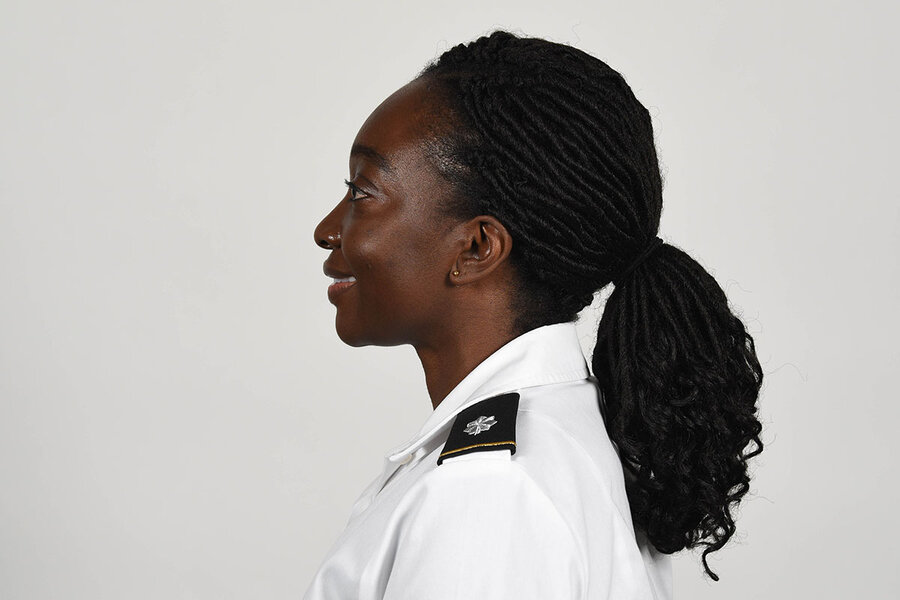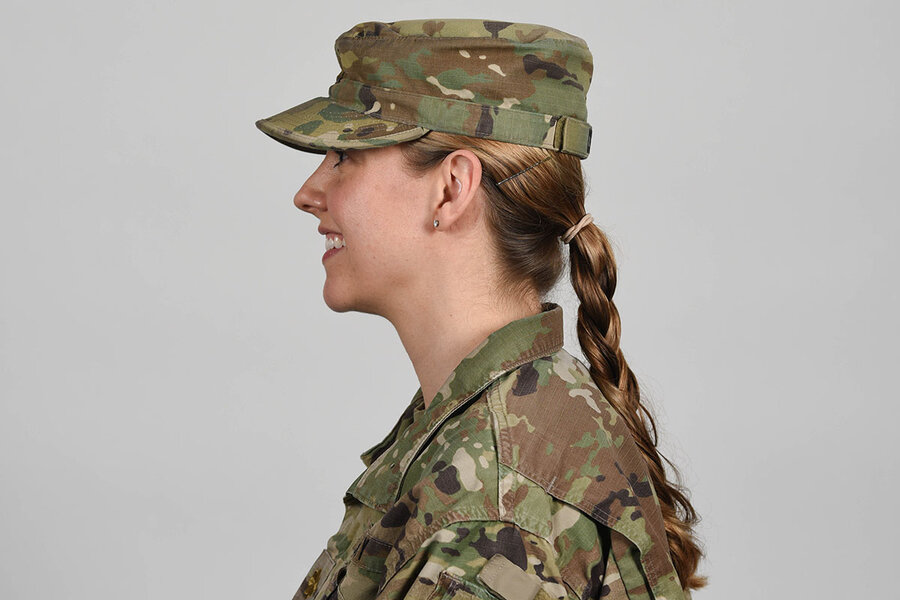Ponytails and braids: Signs of a more inclusive US military
Loading...
In January, the Air Force changed grooming standards for female troops to allow ponytails and braids rather than buns alone. The Army followed suit a few months later, announcing that it is also eliminating from policy guidance words like “eccentric” and “faddish,” which often targeted women of color.
“This really goes back to a larger thing – diversity and inclusion,” Sgt. Maj. of the Army Michael Grinston said. “Are these microaggressions, those things that we were saying that maybe we didn’t know were offensive? Maybe we need to be aware of that.”
Why We Wrote This
What may seem like a superficial change in grooming standards signals a sea change in attitudes about military strength.
The new hairstyle options will also keep women safer. Buns sometimes caused helmets to tip forward, and they made getting a good seal on a gas mask nearly impossible.
Yet what’s making headlines is the shift in thought about how a soldier should look.
“Hair can be seen as a cosmetic thing,” says Maj. Kelly Atkinson, an assistant professor at the U.S. Air Force Academy, “but it’s also a way to recognize that service members come from different genders, different identities. Usually there’s this assumption that masculinity is strength and femininity is weakness. My answer is that the military doesn’t have to be masculine to be successful.”
On a Pentagon stage earlier this year, three senior noncommissioned officers – all men – discussed the merits of changing the Army’s appearance regulations for women.
The town hall, broadcast online, turned to whether women should be allowed to wear stud earrings. “I’m just going to be honest: If you’d asked me before, I would’ve said, ‘No, why do we need earrings?’” said Sgt. Maj. of the Army Michael Grinston.
But task force testimony from behavioral health specialists helped the men see the matter differently, Sgt. Maj. Mark Clark added. “I will tell you, we learned quite a bit” about how old policies affected women “in a masculine Army.” Earrings “kind of helped bridge the gap” for those “who want to serve and be soldiers, but also want to feel like a female at the same time.”
Why We Wrote This
What may seem like a superficial change in grooming standards signals a sea change in attitudes about military strength.
It was a town hall convened to announce sweeping changes to what are known as Army grooming standards, including allowing women to wear ponytails and braids rather than buns alone, and eliminating from policy guidance words like “eccentric” and “faddish,” which “seem to target a specific demographic” of women of color, an Army PowerPoint slide noted.
“This really goes back to a larger thing – diversity and inclusion,” Sergeant Major of the Army Grinston told the town hall. “Are these microaggressions, those things that we were saying that maybe we didn’t know were offensive? Maybe we need to be aware of that.”
“Roger that,” said Sgt. Maj. Brian Sanders, the third man on the panel, who cautioned that the military must guard against “weaponized wording” as well as “clarify what do we mean by ‘professional’ appearance – that is such a subjective term.”
It was an extraordinary exchange among senior noncommissioned officers, who concluded that maybe it’s all right for women to be feminine – or unfeminine, or “eccentric” – in a masculine environment.
And while the revamping of Pentagon regulations related to hair, nails, and jewelry is the first such major change in many years, the larger cultural shift within the U.S. military, analysts say, is how this is expanding ideas about what a soldier should look like in the first place.
“Hair can be seen as a cosmetic thing, but it’s also a way to recognize that service members come from different genders, different identities,” says Maj. Kelly Atkinson, assistant professor of political science at the U.S. Air Force Academy. “Usually there’s this assumption that masculinity is strength and femininity is weakness. My answer is that the military doesn’t have to be masculine to be successful.”
Reactions beyond the military
That remains a threatening idea in many camps. Fox News host Tucker Carlson notoriously attacked new maternity uniforms in a March broadcast, deriding them for making a “mockery of the U.S. military.”
Such notions have been in place since women have been in uniform. In addition to their other duties, they have been expected to walk a fine line between being too feminine – thus raising questions about whether they joined the service to steal some husbands – and being too masculine, risking accusations that they’re just trying to be men, with all the shame those propositions are meant to imply.
What made this decadeslong critique raised by Mr. Carlson different is the way military men quickly joined women in the ranks to set the record straight.
Perhaps Mr. Carlson feels he has “something to prove,” Pentagon press secretary John Kirby, a retired rear admiral, speculated in comments some interpreted as subtly alluding to Mr. Carlson’s lack of military service. In any case, commanders would not be taking “personnel advice from a talk show host,” he added. The Pentagon’s internal press service proclaimed, “Press Secretary Smites Host That Dissed Diversity in U.S. Military.”
Mr. Carlson wasn't the only critic, as Maj. Alea Nadeem, an intelligence officer in the Air Force Reserve, can attest. “We also got some comments like, ‘Oh, you’re just trying to look cute,’” she says. “I can assure you that’s not the case.”
The benefits of braids over buns
Indeed, the changes, officials discovered, are eminently practical and potentially lifesaving. When Major Nadeem was out on the firing range years ago, for example, she wore her long, thick hair in a regulation bun. The problem was that the bun was tipping her helmet forward, making shooting accurately a problem.
She asked instructors if she could undo her hair and tuck it into her collar. “They were like, ‘Sure, whatever you need to do to shoot.’” Afterward, she recalls thinking about what would happen if she was really at war.
Now, as Women’s Initiative team chief for the Air Force’s Barrier Analysis Working Group, Major Nadeem leads the task force that lifted the ban on a number of hairstyles in January, allowing women to wear ponytails and braids, just weeks before the Army followed suit with its own historic changes. These changes, which also include scrapping minimum hair length requirements for women, officially went into effect for soldiers earlier this month.
“Before when they wore their helmets to fly, our female aviators had to take their hair down from a bun and put it in two braids so the helmet would fit. So in order to fly their aircraft, they had to be out of standard,” notes Major Nadeem.
Then there were the gas masks. “The first thing they tell you when you’re female is ‘Take your hair down, because there’s no way you’re going to get a good seal with that bun.’”
In further acknowledgment that the lack of hairstyling options was unhealthy, military officials brought in dermatology consultants and found that one-third of Black female troops were experiencing hair loss, and more than half of women ended their days with tension headaches.
Still, some of the strongest voices against change were servicewomen themselves. “A senior female officer said, ‘Hey, I had headaches too, but I made the choice to cut my hair because I love my country,’” Major Nadeem recalls. “I said, ‘Wouldn’t it be nice if you could serve your country and have your hair?’”
Today, commanders are gradually coming around to such dualities. “I think that’s what I really learned this last year,” Sergeant Major of the Army Grinston told the town hall. “And I was at fault in this: I used to say, ‘We’re all soldiers; I just see green.’” That said, he explained, “not only are you a soldier, but there are other pieces of you that are critical.”
“It’s OK to stand out,” he added. “If people judge you for that, they need to be corrected – not you.”










